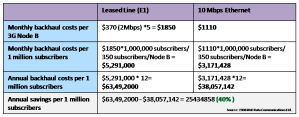With HSPA, EVDO maturing, WiMax getting deployed and LTE getting ready to buzz around, it is soon changing the way mobile phones will access the networks. The bandwidth hungry new services, applications and the non-stop touch clicks on your smart handhelds are eventually going to obsolete these mature 3G networks. Whereas, the 4G access networks are definitely envisioned to control this ever-increasing wireless broadband traffic but what bout the evolution of backhaul?? Is it ready? or is it going to be a major bottleneck analogous to the traffic jams seen if only one lane was operating out of a four lane expressway.
So, let’s have a closer look on how the mobile backhaul network is currently positioned.
The trend below depicts the exponential growth in asynchronous data demand for next 5 years.

Mobile Traffic Projections for the next 5 years
Over the next few years, “user experience” will still continue to rely on 3G (and in some regions on 2G) technology.But for the mobile operator, LTE/WiMax is already part of the game plan. Operators have to learn the technology, and its impact on their networks, applications and service offering. Though, service providers are seeking revenue and profit growth through new differentiated packet-based services. Many of these services, such as mobile Internet and mobile TV, require high bandwidth—and the current backhaul infrastructure is not optimized for handling such traffic. Hence, providers have to add backhaul capacity while keeping operational costs under control, a situation that is forcing carriers to migrate their access and core networks to the new 3G and 4G infrastructure.
There are three main transport technologies in the backhaul arena – fiber, copper and wireless point-to-point microwave.
The costs of backhaul form a significant part of service providers’ revenue accounting for three quarters of mobile transport costs and 25-30% of total operating expenses. The 2G infrastructure carried voice traffic through switched TDM (T1/E1 or SDH/SONET) or ATM. As with 3G/4G services, already the bandwidth requirements have shot exponentially and to transport voice and data efficiently has been the need of the hour.
Basic requirements for a 4G Backhaul network:
1. Capacity: A single tail site should be scalable to 100Mbps+ capacities to avoid bottlenecks
2. Latency: A solution that supports 10msec or less end-to-end latency
3. All IP: Support IP traffic from head to tail.
Current migrating strategy is transporting Ethernet packets over point-to-point Microwave. Over 50% of all mobile backhaul deployments worldwide (and nearly 70% outside the U.S.A.), point-to-point microwave systems offer simple and cost efficient backhauling for voice and high-speed data services. That’s because point-to-point microwave supports higher data rates than traditional copper T1/E1 lines, it delivers between 25% and 60% more bits compared with similar TDM based systems, and easily overcomes the high cost and limited availability associated with fiber. Thus, operators can connect the TDM ports today, and gradually shift traffic to the Ethernet ports in the future. This shift can be done from remote, so no additional CAPEX or OPEX are needed. The industry has already established that the end game of next generation mobile backhaul networks is all-IP/Ethernet. Ethernet is not only more scalable, it also offers huge cost savings across the entire network value chain.

Ethernet cost savings per 1 Million subscribers
Also migrating to high capacity and lower latency Ethernet/All IP network, the systems should also support QoS aware Adaptive Coding and Modulation and Statistical Multiplexing. The former helps optimizing network for spectrum efficiency, increasing the radio capacity and thus reducing cost/bit and latter in optimizing traffic management over the network reducing congestion and improving efficiency. An IP over Ethernet infrastructure has the advantage of the bandwidth growth curve of Ethernet moving from 10 Megabits per second (Mbps) to 10 Gigabits per second (Gbps) today and 100 Gbps in future. This coupled with the decreasing cost of Ethernet ports provides growth opportunities with increasing economies of scale.

Ethernet microwave Vs. TDM microwave equipment cost comparison
Thus, of the three backhaul technology options operators can choose from, wireless point-to-point microwave can deliver the best cost-performance features, bringing faster ROI and driving forward the proliferation of advanced mobile services in the LTE/WiMax era. But in the longer run a hybrid solution of microwave, optical or IP/MPLS core might be seen as a balanced solution that might reduce the OPEX with improved scalability, higher bandwidth, lower latency and better efficiency. So operators pull up the socks and get ready for the great migration.
Also, a point to note with CISCO’s recent acquisition of Starnet Networks which makes it now one of the most dominant player in mobile backhaul solutions market.
From the recent news releases:
Verizon has committed to deploying fiber to 90% of the cell sites in its territory by 2013, closely following VZW’s LTE rollout schedule
Qwest plans to run fiber 7,500 to 17,000 cell sites in its territory
References:
“ATM to ALL IP” Cost effective Network Convergence – Tellabs ‘2009.
“LTE Backhaul Solutions”- Ceragon June 2009
Cable Backhaul: A towering OpportunityWebinar Harris Stratex Networks Nov’2009




 Posted by Neil Shah
Posted by Neil Shah 
